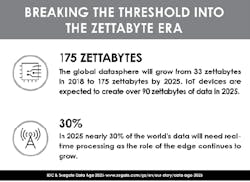The Data Center Edge of Tomorrow: How Digital Twins and AI Will Impact the Network
This launches our article series on the positive impact that digital twins and AI will have on connectivity and the modern network.
In a persistently online world, we are seeing a race to connectivity. The result? More modernization efforts, more reliance on digital infrastructure, and more deployments of colocation, hyperscale, and even cloud architecture.
However, the link that ties them all together is the network.
Our ability to connect is paramount to work and life balances. These digital connections grow in importance every single year. However, not every data center facility is built the same, and not every network architecture for those facilities is designed equally. When working with network and connectivity systems, reducing deployment challenges and ensuring you have an intuitive design is critical. To support emerging requirements, data center leaders must look at reducing complexity, improving efficiency, increasing density, and ensuring a better time-to-market pace.
The hyperscale ecosystem and its breakthrough technologies are turning these unprecedented challenges into opportunities for operators worldwide.
The bottom line is this: Unlike the past, we persistently rely on our ability to connect.
This special report will review the modernization of the network, where there are emerging challenges, and how AI and digital twins are revolutionizing network and connectivity architecture.
Welcome to the digital era in which you are a digital citizen. Our reliance on new forms of communication, interaction, and doing business has evolved over the past decade. However, that evolution hit the accelerator over the past year.
The heart of all of this is your data center. However, the veins supporting this are your connectivity solutions. Before we jump in, it’s vital to understand that there has been a fundamental shift in how we deploy technology solutions and where network modernization impacts physical infrastructure. Too often, we look at modernization efforts as server upgrades and new pieces of software.
However, the network evolution is happening on multiple fronts. These modernization efforts include the cloud, the hyperscale shift, and the application of digital twins and AI into networking architecture and planning.
How connectivity impacts the new cloud and data center balance
Today, the world has around 900 hyperscale data centers, many mopping up services for small corporations or universities that would have previously had their servers. And there are approximately 8600+ colocation and wholesale data center facilities across North America, EMEA, Asia-Pacific, and Latin America.
Here’s another point: There have been proven trends in repatriating workloads back to the data center from cloud computing. For the past two years, the AFCOM State of the Data Center report indicated a significant trend in how organizations view cloud solutions. Definitions are blurred as the cloud takes on a broader meaning where it’s not just public cloud solutions.
Per the latest report, nearly 83% report noticing a trend for organizations to move away from the public cloud and looking to colocation or private data centers. Last year, the majority of respondents also indicated this cloud repatriation trend.
What does connectivity have to do with all of this? Our understanding of cloud workloads, where specific resources should live, and how we can plan for the future are vital considerations. The big difference is that there is a better balance between the cloud and the data center.
The other key point is connecting these cloud and data center solutions. With connectivity modernization impacting digital infrastructure, it’s essential to explore how our physical components are affected. It’s also key to supporting a new cloud and data center balance. Ultimately, this means looking more closely at physical infrastructure, ensuring we properly leverage resources while improving ROI and a company’s speed-to-market.
Download the full report, The Data Center Edge of Tomorrow: Five Critical Ways Digital Twins and AI Will Impact the Network, featuring VIAVI, to learn more. In our next article, we'll explore connectivity modernization, including new design and partner considerations and how to overcome connectivity challenges in the digital age.
About the Author





